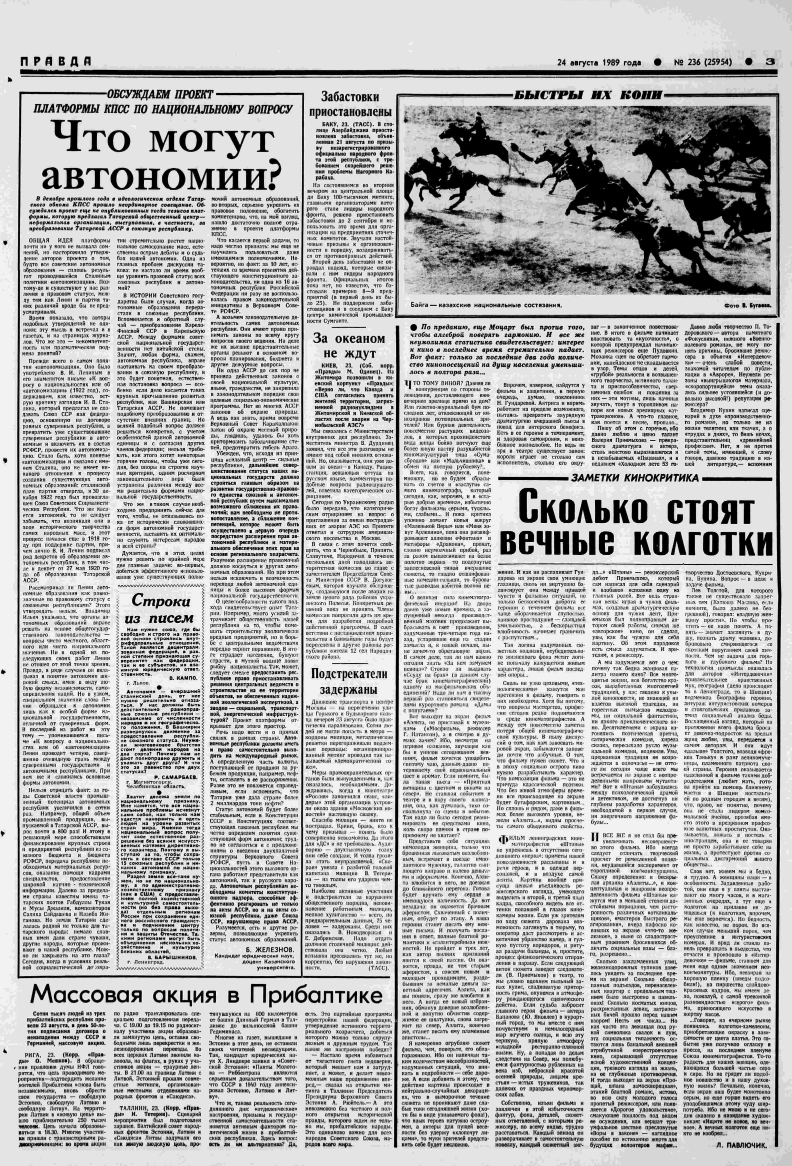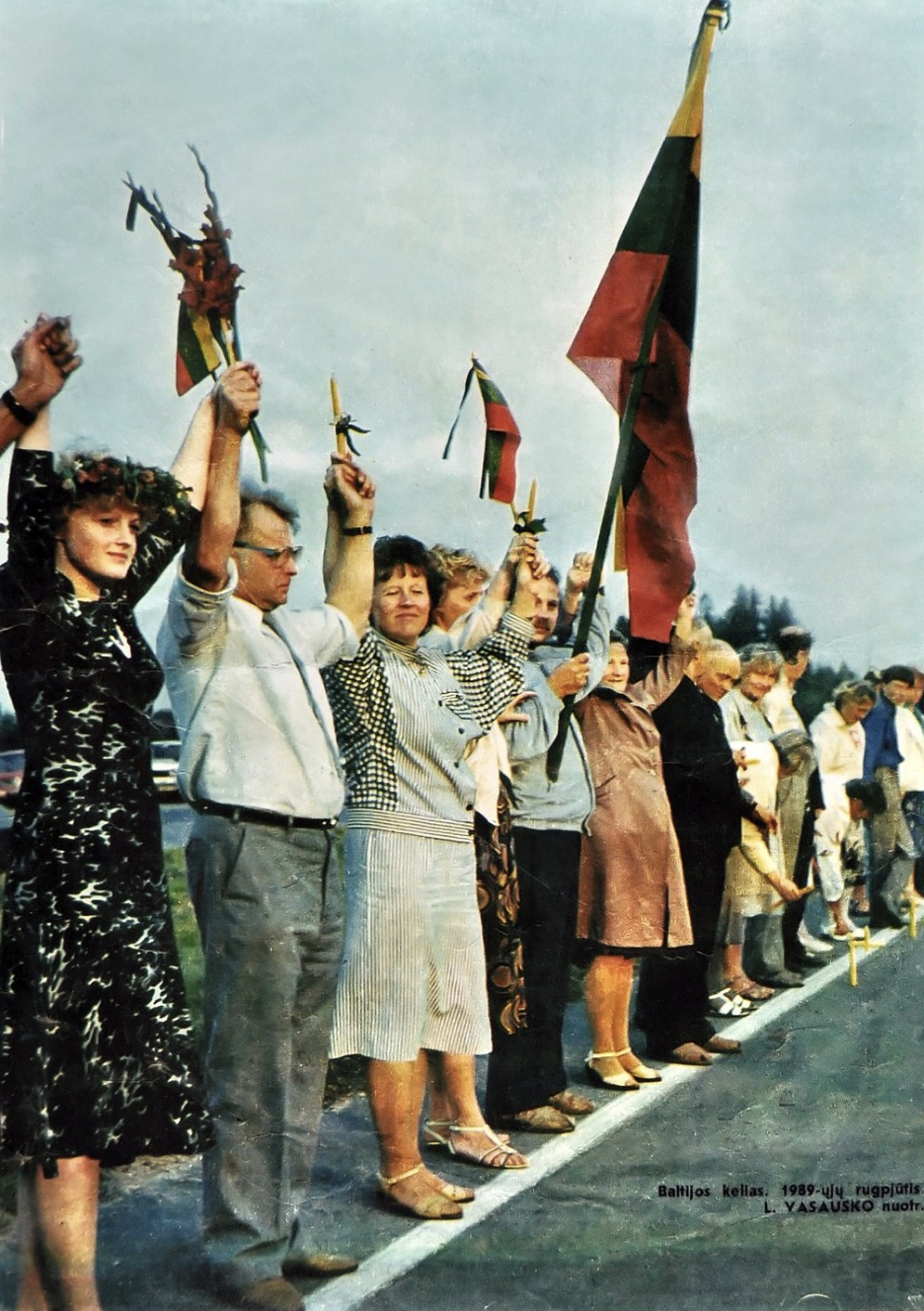Filed Under: Print > Journalism > Human Chain Across the Baltic Republics
Human Chain Across the Baltic Republics
[2 items]
Mass Action in the Baltic States
Hundreds of thousands of people from the three Baltic republics held a mass action on August 23, the 50th anniversary of the signing of the non-aggression pact between the USSR and Germany.
RIGA, 23. (Pravda correspondent O. Meshkov). The address of the NFL council board states that the purpose of the event is to confirm the desire of Baltic residents "to be independent again, to regain their states — free Estonia, free Latvia, and free Lithuania." Approximately 250 thousand people joined the "living chain" in Latvia. The chain began forming at 6:30 PM. Many participants came with transistor radios: during the action, a specially prepared broadcast was transmitted over the radio. From 7:00 PM to 7:15 PM, following a radio signal, participants formed a continuous chain, leaving only intersections and railway crossings free. Bells rang in all churches of Latvia, and participants held mourning ribbons on flags and in their hands. At 9:00 PM, joint rallies organized by local branches of the popular fronts and "Sąjūdis" were held at the borders of Latvia with Lithuania and Estonia.
TALLINN, 23. (Pravda correspondent I. Teterin). The event's scenario was prepared in advance. The Baltic Council of Popular Fronts of Estonia, Latvia, and Lithuania's "Sąjūdis" conceived it as a living human chain stretching 600 kilometers from the Long Hermann Tower in Tallinn to the Gediminas Tower in Vilnius.
Many newspapers published in Estonia that day kept their readers well-informed. For instance, candidate of legal sciences H. Lindpere stated in "Soviet Estonia": "The Molotov-Ribbentrop Pacts are serious evidence that the USSR annexed Estonia, Latvia, and Lithuania in 1940." Well, this is today's reality: "separatist" sentiments and calls for state independence are becoming an active factor in political life in the Baltic republics. Here's the question: is there an alternative to them? Yes, there is. These are party programs for restructuring our federation, establishing true territorial economic accountability, which can only be achieved through meticulous and united work. So which sentiments will prevail?
"The time has come to get rid of the burdensome oppression of distrust that hinders us and makes our progress difficult, perhaps even impossible," said the Chairman of the Presidium of the Supreme Soviet of Estonia, A. Rüütel, at the opening of the rally in Tallinn. "And this is impossible without an honest and complete revelation of historical truth, which not only we, the Baltic peoples, are waiting for. This is equally important for all peoples of the Soviet Union and peoples around the world."
On 23 August 1989, hundreds of thousands of residents of the Baltic Republics of Lithuania, Latvia, and Estonia created a human chain (Russian: zhivaia tsep’) over a 600-kilometer stretch of territory from Tallinn to Vilnius. The date was significant: it marked the fiftieth anniversary of the signing of the Molotov-Ribbentrop Pact of Nonaggression between the USSR and Nazi Germany in 1939, which stated that, should Germany go to war against Poland, the Soviet Union would not declare war on Germany. Additionally, secret provisions of the Treaty included agreements about territorial acquisitions. Should Germany invade Poland, the Nazis would lay claim to the western portion of the state, while the Soviet Union would occupy parts of current-day Belarus, Poland, Lithuania, Latvia, and Estonia. When Nazi forces invaded Poland in September 1939, all protocols of the Molotov-Ribbentrop Pact were put into action, resulting in the USSR’s de facto annexation of the Baltic states.
The issue of the secret protocols of the Molotov-Ribbentrop Pact erupted in a very public way in May-June 1989 at the First USSR Congress of People’s Deputies in Moscow. Every minute of the proceedings was broadcast live on television, while newspapers offered comprehensive coverage of plenary discussions. In the Fifth Session on 29 May 1989, Lithuanian delegate E.B. Bichkauskas raised the question of the Pact, demanding that the entire document be made public for the benefit of all Soviet citizens. Previously and even for a time at the Congress, Soviet leaders had denied having any hard copies of the Pact. This line was difficult to sustain, though, because the West German government had made them public much earlier. By the end of the Congress, Gorbachev promised to release the document to the public.
Official acknowledgment of the Molotov-Ribbentrop Pact by the Soviet government weakened claims of legitimate control over the Baltic States. It transpired that the Soviet governments in Lithuania, Latvia, and Estonia had not been created through popular elections, as the Soviet narrative went, but by annexation. Yet the question of Soviet sovereignty in the Baltics was already a fraught issue before the First USSR Congress of People’s Deputies. On 16 November 1988, Estonia had been the first Soviet republic to declare independence from the Soviet government. After the release of official copies of the Molotov-Ribbentrop Pact, the independence of all three Baltic states seemed increasingly inevitable.
The Human Chain of 23 August 1989 constituted a masterful, peaceful protest against the Molotov-Ribbentrop Pact and the years of oppression and secrecy it stood for. The coverage of the event in Pravda, the press organ of the Soviet Communist Party and still one of the main national Soviet daily newspapers, hardly did justice to the significance of the event on a national or global scale. Coverage appeared the next day on page 6 of the newspaper, without any photographs. And yet, even this article, in this publication, did not mince words and did not criticize or undermine the protest, which attests to how much more open the Soviet press (especially those media organs controlled by the state) had become in the course of perestroika.
A comparison to the coverage of protests in Tbilisi, Georgia on 9 April 1989 lays bare the inequities in the distribution of violence along geographic lines—protests in the Caucasus were met with more violence than protests in the Baltics, which bordered Western Europe. The comparison also shows how much the central government, and especially the press, had changed over the course just of 1989.

